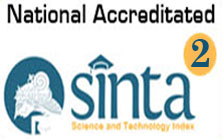The Impact of Aging on the Quality of Sperm in White Rats (Rattus Norvegicus) Wistar Strain
DOI:
https://doi.org/10.31965/infokes.Vol21.Iss2.872Keywords:
Aging, Morphology, Viability, Motility, SpermatozoaAbstract
Due to the reproductive aging process, the testes, epididymis, and other reproductive organs gradually lose all their physiological capabilities. This study aimed to determine the effect of aging on the sperm quality of Wistar rats (Rattus Norvegicus). The research design is quantitative and descriptive. This study used white male rats (Rattus norvegicus) of the Wistar strain aged 19–20 months. The number of samples was 18 individuals, with a purposive sampling technique following the inclusion and exclusion criteria. Mice were put to sleep on the seventh day, then the cauda epididymis and testes were separated, and a media container was used to accommodate them. The spermatozoa produced were then examined for their motility, morphology, and viability. The results showed that the range, mean, and standard deviation of progressive motility of spermatozoa was 5.83%, 217% ± 1.87%, normal morphology was 39.17%, 61.6% ± 9.57%, and spermatozoa viability was 19.50%, 74.6 ± 5.83%. There was a progressive decrease in motility, but morphology was expected, and spermatozoa viability was within normal limits. This study concludes that aging affects spermatozoa motility, but the morphology and viability of spermatozoa are still within normal limits. Future studies should do genetic analysis to determine how hereditary factors affect the quality of sperm in aged white rats and compare the results to those of young rats to identify changes in sperm quality.
Downloads
References
Alahmar, A. T. (2019). Role of oxidative stress in male infertility: an updated review. Journal of human reproductive sciences, 12(1), 4–18. Available at https://www.ncbi.nlm.nih.gov/pmc/articles/PMC6472207/
Asadi, A., Ghahremani, R., Abdolmaleki, A., & Rajaei, F. (2021). Role of sperm apoptosis and oxidative stress in male infertility: A narrative review. International Journal of Reproductive BioMedicine, 19(6), 493-504. https://doi.org/10.18502/ijrm.v19i6.9371
Baker, K., Li, J., & Sabanegh Jr, E. (2015). Analysis of semen parameters in male referrals: impact of reference limits, stratification by fertility categories, predictors of change, and comparison of normal semen parameters in subfertile couples. Fertility and Sterility, 103(1), 59-65. https://doi.org/10.1016/j.juro.2015.06.056.
Bisht, S., Faiq, M., Tolahunase, M., & Dada, R. (2017). Oxidative stress and male infertility. Nature Reviews Urology, 14(8), 470-485. https://doi.org/10.1038/nrurol.2017.69
Bjorndahl, L. and Brown, J.K. (2022). The sixth edition of the WHO Laboratory Manual for the Examination and Processing of Human Semen : ensuring quality and standardization in basic examination of human ejaculates. Fertility and Sterility, 117(2), 246-251. https://doi.org/10.1016/j.fertnstert.2021.12.012.
Carmona, J. J., & Michan, S. (2016). Biology of healthy aging and longevity. Revista de investigacion clinica, 68(1), 7-16.
Conti, V., Izzo, V., Corbi, G., Russomanno, G., Manzo, V., De Lise, F., ... & Filippelli, A. (2016). Antioxidant supplementation in the treatment of aging-associated diseases. Frontiers in pharmacology, 7, 24. https://doi.org/10.3389/fphar.2016.00024
Costabile, R. (2013). Anatomy and physiology of the male reproductive system in Surgical and Medical Management of Male Infertility. Cambridge: Cambridge University Press.
Evans, E. P., Scholten, J. T., Mzyk, A., Reyes-San-Martin, C., Llumbet, A. E., Hamoh, T., ... & Cantineau, A. E. (2021). Male subfertility and oxidative stress. Redox Biology, 46, 102071. https://doi.org/10.1016/j.redox.2021.102071
Fatehi, D., Moayeri, A., Rostamzadeh, O., Rostamzadeh, A., & Kebria, M. M. (2018). Reactive oxygenated species (ROS) in male fertility; source, interaction mechanism and antioxidant therapy. Research Journal of Pharmacy and Technology, 11(2), 791-796. https://doi.org/10.5958/0974-360X.2018.00150.6
Fricke, C., & Koppik, M. (2019). Male reproductive ageing: a tale of the whole ejaculate. Reproduction, 158(6), R219-R229. https://doi.org/10.1530/REP-18-0579.
Gunes, S., Hekim, G. N. T., Arslan, M. A., & Asci, R. (2016). Effects of aging on the male reproductive system. Journal of assisted reproduction and genetics, 33, 441-454. https://doi.org/10.1007/s10815-016-0663-y.
Henkel, R., Sandhu, I. S., & Agarwal, A. (2019). The excessive use of antioxidant therapy: A possible cause of male infertility?. Andrologia, 51(1), e13162. https://doi.org/10.1111/and.13162
Hernandez-Segura, A., Nehme, J., & Demaria, M. (2018). Hallmarks of cellular senescence. Trends in cell biology, 28(6), 436-453. https://doi.org/10.1016/j.tcb.2018.02.001.
Hook, K. A., & Fisher, H. S. (2020). Methodological considerations for examining the relationship between sperm morphology and motility. Molecular reproduction and development, 87(6), 633-649. https://doi.org/10.1002/mrd.23346.
Luceri, C., Bigagli, E., Femia, A. P., Caderni, G., Giovannelli, L., & Lodovici, M. (2018). Aging related changes in circulating reactive oxygen species (ROS) and protein carbonyls are indicative of liver oxidative injury. Toxicology reports, 5, 141-145. https://doi.org/10.1016/j.toxrep.2017.12.017
Majzoub, A. & Sabanegh, E. (2017). Making a diagnosis’, in N. Aziz and A. Agarwal (eds) The Diagnosis and Treatment of Male Infertility. Springer, Cham. https://doi.org/10.1007/978-3-319-56547-7_1
Mehrotra, A., Katiyar, D. K., Agarwal, A., Das, V., & Pant, K. K. (2013). Role of total antioxidant capacity and lipid peroxidation in fertile and infertile men. Biomed Res, 24(3), 347-352.
Nago, M., Arichi, A., Omura, N., Iwashita, Y., Kawamura, T., & Yumura, Y. (2021). Aging increases oxidative stress in semen. Investigative and clinical urology, 62(2), 233-238. https://doi.org/10.4111/icu.20200066.
Nguyen-Powanda, P., & Robaire, B. (2020). Oxidative stress and reproductive function in the aging male. Biology, 9(9), 282. https://doi.org/10.3390/biology9090282.
Pamungkas, F. A. (2012). Spermatozoa dari kauda epididimis: kriopreservasi dan pemanfaatan untuk inseminasi buatan dan fertilisasi in vitro. Wartazoa, 22(4), 178-86.
Panel, M., Ghaleh, B., & Morin, D. (2018). Mitochondria and aging: A role for the mitochondrial transition pore?. Aging cell, 17(4), e12793. https://doi.org/10.1111/acel.12793
Parwata, O.A. (2015). Uji Bioaktivitas : Antioksidan. Denpasar: Universitas Udayana.
Pino, V., Sanz, A., Valdés, N., Crosby, J., & Mackenna, A. (2020). The effects of aging on semen parameters and sperm DNA fragmentation. JBRA assisted reproduction, 24(1), 82–86. https://doi.org/10.5935/1518-0557.20190058.
RR. Dias, T., Martin-Hidalgo, D., M. Silva, B., F. Oliveira, P., & G. Alves, M. (2020). Endogenous and exogenous antioxidants as a tool to ameliorate male infertility induced by reactive oxygen species. Antioxidants & redox signaling, 33(11), 767-785. https://doi.org/10.1089/ars.2019.7977.
Sabeti, P., Pourmasumi, S., Rahiminia, T., Akyash, F., & Talebi, A. R. (2016). Etiologies of sperm oxidative stress. International Journal of Reproductive Biomedicine, 14(4), 231–240. https://doi.org/10.29252/ijrm.14.4.231.
Sengupta, P. (2013). The laboratory rat: relating its age with human's. International journal of preventive medicine, 4(6), 624–630.
Simbolon, I. S., Lubis, T. M., & Adam, M. (2013). Persentase spermatozoa hidup pada tikus wistar dan Sprague-dawley. Jurnal Medika Veterinaria, 7(2). https://doi.org/10.21157/j.med.vet..v7i2.2935.
Torres-Arce, E., Vizmanos, B., Babio, N., Marquez-Sandoval, F., & Salas-Huetos, A. (2021). Dietary antioxidants in the treatment of male infertility: Counteracting oxidative stress. Biology, 10(3), 241. https://doi.org/10.3390/biology10030241.
Wagner, K. H., Cameron-Smith, D., Wessner, B., & Franzke, B. (2016). Biomarkers of aging: from function to molecular biology. Nutrients, 8(6), 338. https://doi.org/10.3390/nu8060338.
Wang, J. J., Wang, S. X., Tehmina, Feng, Y., Zhang, R. F., Li, X. Y., ... & Ding, J. (2022). Age-related decline of Male fertility: Mitochondrial dysfunction and the antioxidant interventions. Pharmaceuticals, 15(5), 519. https://doi.org/10.3390/ph15050519
Downloads
Published
How to Cite
Issue
Section
License
Copyright (c) 2023 JURNAL INFO KESEHATAN

This work is licensed under a Creative Commons Attribution-NonCommercial-ShareAlike 4.0 International License.
Copyright notice
Ownership of copyright
The copyright in this website and the material on this website (including without limitation the text, computer code, artwork, photographs, images, music, audio material, video material and audio-visual material on this website) is owned by JURNAL INFO KESEHATAN and its licensors.
Copyright license
JURNAL INFO KESEHATAN grants to you a worldwide non-exclusive royalty-free revocable license to:
- view this website and the material on this website on a computer or mobile device via a web browser;
- copy and store this website and the material on this website in your web browser cache memory; and
- print pages from this website for your use.
- All articles published by JURNAL INFO KESEHATAN are licensed under the Creative Commons Attribution 4.0 International License. This permits anyone to copy, redistribute, remix, transmit and adapt the work provided the original work and source is appropriately cited.
JURNAL INFO KESEHATAN does not grant you any other rights in relation to this website or the material on this website. In other words, all other rights are reserved.
For the avoidance of doubt, you must not adapt, edit, change, transform, publish, republish, distribute, redistribute, broadcast, rebroadcast or show or play in public this website or the material on this website (in any form or media) without appropriately and conspicuously citing the original work and source or JURNAL INFO KESEHATAN prior written permission.
Permissions
You may request permission to use the copyright materials on this website by writing to jurnalinfokesehatan@gmail.com.
Enforcement of copyright
JURNAL INFO KESEHATAN takes the protection of its copyright very seriously.
If JURNAL INFO KESEHATAN discovers that you have used its copyright materials in contravention of the license above, JURNAL INFO KESEHATAN may bring legal proceedings against you seeking monetary damages and an injunction to stop you using those materials. You could also be ordered to pay legal costs.
If you become aware of any use of JURNAL INFO KESEHATAN copyright materials that contravenes or may contravene the license above, please report this by email to jurnalinfokesehatan@gmail.com
Infringing material
If you become aware of any material on the website that you believe infringes your or any other person's copyright, please report this by email to jurnalinfokesehatan@gmail.com.



















